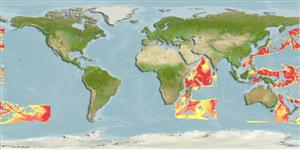>
Aulopiformes (Grinners) >
Ipnopidae (Deep-sea tripod fishes) > Ipnopinae
Etymology: Ipnops: Greek, hypnos = sleep + Greek, ops = appearance (Ref. 45335).
Eponymy: Dr Giles Willis Mead Jr (1928–2003) was an American zoologist and curator. [...] (Ref. 128868), visit book page.
More on author: Nielsen.
Environment: milieu / climate zone / depth range / distribution range
Ecología
marino batidemersal; rango de profundidad 3310 - 4940 m (Ref. 82809). Deep-water
Western Indian Ocean: off Kenya (Ref. 40966). Western Central Pacific.
Tamaño / Peso / Age
Maturity: Lm ? range ? - ? cm
Max length : 12.1 cm SL macho / no sexado; (Ref. 82809)
Life cycle and mating behavior
Madurez | Reproducción | Puesta | Huevos | Fecundidad | Larva
Paxton, J.R. and V.H. Niem, 1999. Ipnopidae: tripod fishes. p. 1923-1924. In K.E. Carpenter and V.H. Niem (eds.) FAO species identification guide for fishery purposes. The living marine resources of the Western Central Pacific. Vol. 3. Batoid fishes, chimaeras and bony fishes. Part 1 (Elopidae to Linophrynidae). FAO, Rome. (Ref. 39810)
IUCN Red List Status (Ref. 130435: Version 2024-2)
Threat to humans
Harmless
Human uses
Pesquerías: sin interés
Herramientas
Special reports
Download XML
Fuentes de Internet
Estimates based on models
Preferred temperature (Ref.
123201): 0.9 - 1.9, mean 1.5 °C (based on 1908 cells).
Phylogenetic diversity index (Ref.
82804): PD
50 = 0.6250 [Uniqueness, from 0.5 = low to 2.0 = high].
Bayesian length-weight: a=0.01000 (0.00244 - 0.04107), b=3.04 (2.81 - 3.27), in cm total length, based on all LWR estimates for this body shape (Ref.
93245).
Nivel trófico (Ref.
69278): 3.3 ±0.4 se; based on size and trophs of closest relatives
Resiliencia (Ref.
120179): Medio, población duplicada en un tiempo mínimo de 1.4-4.4 años (Preliminary K or Fecundity.).
Fishing Vulnerability (Ref.
59153): Low vulnerability (10 of 100).
